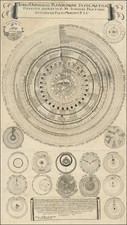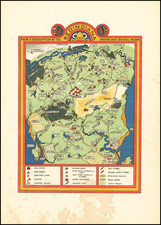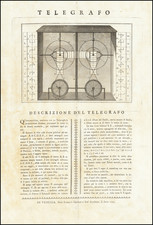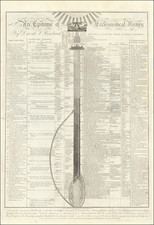Houyhnhnms Land and the Coast of Australia -- From Gulliver's Travels
The Houyhnhnms are a race of intelligent horses described in the last part of Jonathan Swift's satirical Gulliver's Travels.
The map shows Houyhnhnms Land to be south of Australia; it indicates Edels Land and Lewins Land to the north, and Nuyts Land to the north-east, on the mainland with the islands of St Francis and St Pieter further east, and Sweers, Maatsuyker and De Wit islands to the east. The map is somewhat careless with the scale, however; Edels Land to Lewins Land are shown adjacent, while in reality they are some 600 miles apart, while the sweep of the Great Australian Bight, from Cape Leeuwin, Australia's south-westerly point to the Maatsuyker Islands, off the southern tip of Tasmania, is nearly 2000 miles.
The Houyhnhnms are rational, equine beings and are masters of the land, contrasting strongly with the Yahoos, savage humanoid creatures who are no better than beasts of burden, or livestock. Whereas the Yahoos represent all that is bad about humans, Houyhnhnms have a settled, calm, reliable and rational society. Gulliver much prefers the Houyhnhnms' company to the Yahoos', even though the latter are biologically closer to him.
The map appeared in Gulliver's Travels. The full title is:
Travels Into Several Remote Nations of the World; By Lemuel Gulliver, First a Surgeon, and then a Captain of Several Ships. In Four Parts. Part I. A Voyage to Lilliput. Part II. A Voyage to Brobdingnag. Part II. A Voyage to Laputa, Balnibarbi, Luggnagg, Glubbdubrib, and Japan. Part IV. A Voyage to the Country of the Houyhnhnms. London, Printed for C. Bathurst. MDCCLXVIII
Gulliver's Travels is a prose satire by Irish writer and clergyman Jonathan Swift, that is both a satire on human nature and the "travellers' tales" literary subgenre. It is Swift's best known full-length work, and a classic of English literature. He himself claimed that he wrote Gulliver's Travels "to vex the world rather than divert it". The book became popular as soon as it was published. John Gay wrote in a 1726 letter to Swift that "It is universally read, from the cabinet council to the nursery."
Gulliver begins his travels in May of 1699 and travels until December 1715.
The present map appeared in the 1768 edition of the book.









![A Geographical Chart: or, A Scheme, Comprehending The Most Important Particulars Relative To The Geography of North and South-America. : Designed to be an Auxiliary to the Student. Carefully Compiled from the Best authorities, by Amos Bingham [Copy-Right Secured]](https://storage.googleapis.com/raremaps/img/small/41406.jpg)



![Boussole des vents ou leurs noms tant Anciens que Modernes sont Diuisez en six Cercles suivant les principales Nations de l'Europe [Compass Rose & Wind Heads]](https://storage.googleapis.com/raremaps/img/small/84965.jpg)
